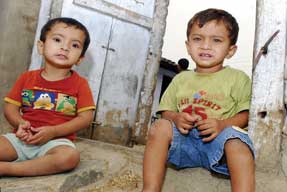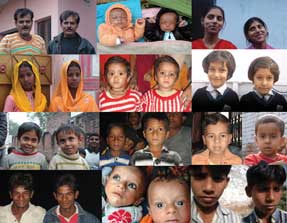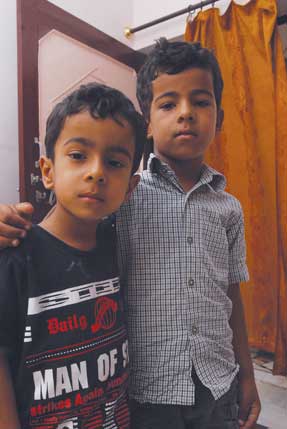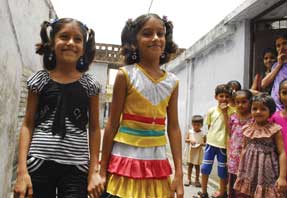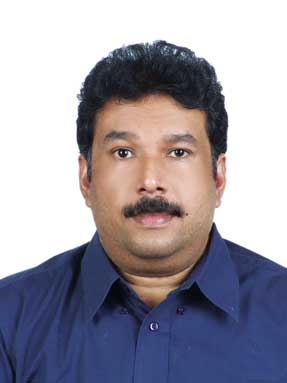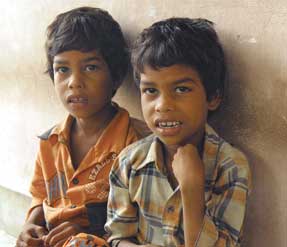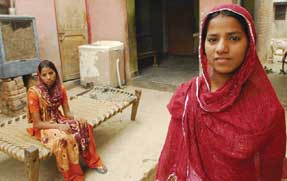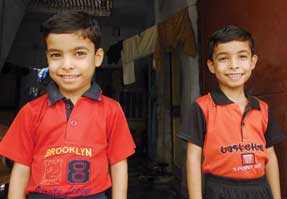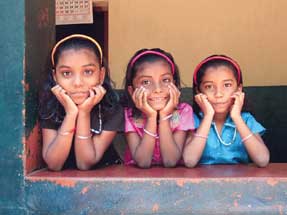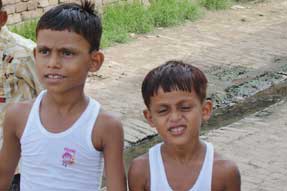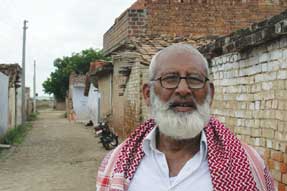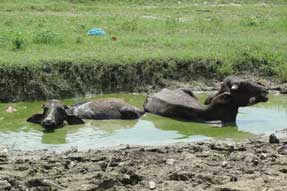India
Twin Capital Of The World
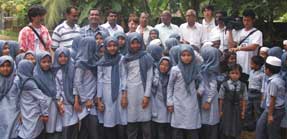
|
It’s Eid in the village of Mohammadpur Umri, which is 95 percent Muslim. A perfect day to enjoy loads of biryani and sewai. But it also happens to be 9/11 and a fanatical U.S. priest had announced plans to burn the Quran on this day. With a surname of Alexander, I was a tad apprehensive.
Umri sits about 8 miles from the Allahabad Railway Station, at the edge of the Bamrauli Air Force Base Station, sandwiched on the northern end between the Airforce Sports Complex and the Kendriya Vidyalaya. The village is a throwback to another era, dotted with mud wall and thatched roof kutcha huts that stand in stark contrast to the sturdy and beautifully painted Air Force blocks, seemingly teasing the village, along the 30-minute scooter rickshaw ride to the village from the train station. One colony on the corner of Umri even sports the title “Happy Home.”
For all its modesty, Umri was bursting with the joy and celebrations of Eid. Children were donned in colorful, jazzily embroidered clothes. Small shops hawking sweets, homemade candies and churan were crowded with little customers whose pockets were brimming with Eidi — money gifted to them by elders and family — with which they were busily selecting their choice flavors.
Raju, the harried shopkeeper, seemed to be the only grave face in the crowd, burdened by an unusual problem: “Imagine this, a young boy comes and asks for a tangy and sour combination, once you are ready with the mixture, the kid asks for a contrary sweet combination and when I scold him, he has a genuine justification. That order was placed by his twin brother not him. You can’t argue any further. They all have their photocopies running around.”
Indeed, most of the children at his store are in duplicate. Moreover, the lookalikes all seem to wear similar dresses, making Raju’s task ever so befuddling. Village school teacher Mohd Imran narrates a similar tale: “At times my twin students succeed in fooling me by sharing the same homework copy and showing it one by one. And there are moments when one student gets punished for the misdeed of his twin brother. Such humorous incidents happen in this village all the time.”
The hamlet of 300 households boasts 54 pair of twins. With twins in every fifth home Umri has the highest proportion of twins anywhere in the world. The villagers are friendly and courteous, but with the growing number of researchers, media and tourists flooding in, they are increasingly impatient with visitors. The friendliest is Achchan Miyan, the senior most member of Umri. He explains the villagers’ aversion to outsiders: “I know that the name of our village is getting popular across the globe day by day, but what do we get in return? Not that we expect any monetary favors.
But everybody coming down to this place has his own agenda and interest. None highlighted our apathy. Even with this level of not–so-normal phenomena prevalent, we don’t have a single doctor to serve in this village. Complications with twin delivery are obvious and not that easy to cope with.” According to Miyan, the village would have even more twins if it had better medical facilities, as the mortality rate of twin babies is high. Legend has it… The twin birth phenomenon in Umri dates back atleast 40 years with the birth of twin sisters, and, villagers say, it roughly coincides with the setting of an Air Force base station near the village. The village boasts a twin monozygotic (MZ) or identical twin birth rate that is 300 times the national average and perhaps the highest in the world. Few homes in the village are untouched by the phenomenon and some have even more than one pair of twins. One Umri family has four pairs of twins. All but the parents in the 10-person family are twins. Achchan Miyan himself fathered a pair of twin boys. The oldest surviving twins in Umri are popularly known as Guddu Judwa and Munnu Judwa.
The high incidence of multiple births has attracted international medical and media attention, including a team of experts led by Dr Bruno Reversade, a developmental biologist from Singapore’s Institute of Medical Biology (IMB). Reversade, who visited Umri to collect saliva and blood samples of the Umri denizens, says, “I am confident that a particular allele (genetic variant) shared by most MZ twins will account for this extraordinary phenomenon.” His opinion is shared by Dr Saranjeet Singh, a health scientist affiliated with the World Health Organization: “The biggest factor, in my opinion, is genetic. If you have a history of multiples in your family, in all probability you have also inherited the gene for ‘hyperovulation’ — tendency of conceiving twins.”
Singh explains that normally just one egg is released from the ovary each month, which then travels through the fallopian tube and enters the uterus waiting to be fertilized. Hyperovulation occurs when more than one egg is released by a woman during her monthly menstrual cycle. This release of multiple eggs increases the chance of conceiving fraternal twins or even triplets. People can carry a gene, popularly called the “twin gene” for this pattern of hyperovulation and can pass it on to their children. The village has also been visited by DNA experts from the Centre for Cellular and Molecular Biology (CCMB) in Hyderabad. With support from the local administration, the CCMB team was able to gather the largest saliva and blood samples from Umri. The DNA study was clouded by a cruel hoax that falsely claimed that the government had allotted Rs 1 crore ($200,000) for the project, some of which would be distributed amongst villagers providing samples.
Dr Lalji Singh, director of CCMB, says that in India there is a 1 chance in 80 for a mother to deliver twins and 1 in 300 for delivering identical twins. In Umri, however, one of ten deliveries result in identical twins — over 300 times the national average. Singh attributes the twinning to the high rate of inbreeding in Umri and the CCMB study hopes to identify the gene responsible — if there is one. Singh’s theory is shared by IMB’s Bruno, who told Little India by email: “Our initial genetic overview, based on nearly a dozen pairs of identical twins (which have been ascertained by genotyping) and some of their parents, reveal that this is indeed an inbred village. We also find no interracial mixing meaning that despite having a mixed Hindu/Muslim community at Umri, no crossovers have been observed. Because so many twins are born here, we keep collecting their DNA, thanks to our local contacts. In the last six months also, we have collected DNA samples of two pairs of identical twins.” Worlds Apart Twins
The medical speculation that twining is caused by genes and DNA because of inbreeding is questioned by Achchan Miyan: “How would you explain the twin births in non-Muslim members of the village?” Non-Muslims constitute just five percent of the village population, but they have experienced twin births as well. Villagers also point to twin births seeping into animals and birds? Umri abounds in hens that lay eggs with double yolks and even a handful of twin cows and buffaloes. Many villagers attribute the phenomena to the Air Force Base Station and the defence’ experimentation machinery. Others are convinced that twin births are “God’s gift” or there is something in the soil and water. Umri vies with Kodinhi, Kerala, as India’s twin capital. That hamlet of 2,000 families boasts 250 sets of twins. In 2008, of 300 births, 15 — almost 5 percent — were twin births.
Sribiju MK, a physician at the Tirurangadi Taluk hospital, bordering Kodinhi, has been studying the high twin birth rate in Kodinhi for a decade now. He rejects inbreeding as the cause of twinning in Umri, arguing: “There must be something that is stimulating the ovaries to produce eggs. In some Western countries specific drugs are used to cure infertility. They stimulate the ovaries leading to a release of multiple eggs and hence the rise in twinning rate. But in places like Umri and Kodinhi there is rare possibility of any such artificial chemical to blame.” Sribiju suspects that something in the natural environment is responsible for the high twinning rates in these villages: “I have collected the samples of air, water and soil, etc., all the possibly causative natural elements from Kodinhi. It is a Herculean task to track the exact of the heavy metals that could be present in any of these elements stimulating the working of the ovary.” He plans to visit Mohammadpur Umri as well to collect samples to test his theories.
While the villages of Mohammadpur Umri and Kodinhi may share the twinning propensity they are worlds apart. Umri is a village of poor, mostly illiterate community of landless farmers and milkmen. All the land in the surrounding area has been claimed by the Air Force and the inhabitants are left to migrate or survive with odd jobs. Kodinhi, on the contrary, boasts of wealthy families, many of them bolstered by remittances from family members working in the Gulf. A doctor has served the village for more than 10 years now and the village even has a twins association, which manages a website promoting itself globally. Double Trouble
After the evening namaz, Ismail Hafiz, the imam at the newly built Umri Masjid traced the earliest pair of twins born in Umri to soon after Independence in 1947. One of the twins died and similar tragedies abound in the village. According to Achchan Miyan: “The rate of twin births is growing, but infant mortality is equally rising. You would have seen many more twins around had it not been so.” With his twin son Ishan smiling proudly beside him, Miyan complained that raising twins is “double the trouble” for the family. “They tend to do same things at the same time. They play, cry, laugh, eat and fall sick together too. Medical expense of delivering and raising a twin is very high. With our small income, it’s truly a difficult job.”
Other families piped in with their own dilemmas in raising twins, even to the point of mixing up which child was actually ill. “Instead of giving medicines to the one who’s ill, it has often happened that I gave medicines to my second son,” says the mother of the youngest twins in the village Samad and Saad. Her husband quips, “Given Samad’s mischievousness and exceptional agility and Saad’s sluggishness and coyness, little wonder if Samad has been given even his brother’s share of health tonics!” Miyan says the village once flourished with huge farmlands and fertile soil nourished by the Ganges and Yamuna. The British colonial authorities leased land from the villagers for temporary military camps. Following Independence, however, according to Miyan, the lease payments stopped and the temporary camps were converted into a permanent Air Force base. The turn of events left villagers indigent and many left their homes to make a living in surrounding towns. Ishan’s twin brother Dilshan lives in the neighboring industrial city of Kanpur. The moistness in his eyes conveyed just how deeply he missed his twin sibling Dilshan, with whom he once shared every joy and pain, but who was miles away even on Eid, “My Eid completes with his hug only.”
|


